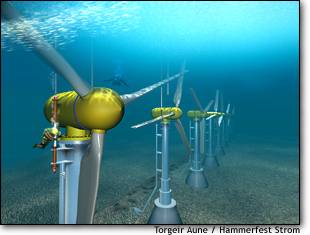|
In a novel use of clean energy, the world’s most northerly town will soon be the first to get electricity from an underwater power station run on tidal currents tugged by the moon. Gigantic forces in the oceans — waves, currents and tides — have often proved too costly or awkward to harness, compared with wind or solar power, in the global efforts to cut reliance on nuclear power or on fossil fuels blamed for global warming. However, a tidal current will start turning the blades of a windmill-like turbine standing on the seabed near Kvalsund at the Arctic tip of Norway. “We will be the first in the world to use tidal currents to generate electricity to be fed into the local grid,” stated Harald Johansen, managing director of Hammerfest Stroem. Other unorthodox sub-sea experiments to generate power from tidal currents from Australia to Britain have not gotten to the stage of selling power. All the technologies mark a shift in traditional methods of exploiting the tide. Tides have previously been tapped for use in power plants in France, Canada and |
|
|
Russia by building barrages to trap water in artificial lagoons at high tide. When the tide goes out, gravity sucks the water through turbines to generate electricity. These giant damming
projects are out of fashion because they can damage the ecology of rivers
and coastlines. Seabed turbines, are silent and invisible, and fish
can swim around them without getting sliced up. “Of all the renewable
energy technologies, ocean energy is probably the one in the earliest
stages,” said Mark Hammonds at the International Energy Agency in Paris,
“This is because many of these projects are too costly.” Hammerfest, with 11,000 inhabitants, calls itself the world’s northernmost town. Johansen says the project there has cost 50 million Norwegian crowns ($6.7 million) so far and will cost twice that much by completion in 2004. High oil prices and pledges to curb emissions of greenhouse gases as part of the Kyoto pact to limit global warming, blamed on emissions from burning coal or oil, are helping make green technologies like tidal power more attractive despite their drawbacks. Other systems to
tap the oceans range from giant snakelike tubes that generate power when
rocked by waves, to machines that extract power from the contrast between
warm surface waters and chill temperatures at ocean depths. Experts
are uncertain about the potential, especially because of sub-sea maintenance
costs. Storms have wrecked many experimental ocean power stations.
“We need to harness all low-impact renewables we can develop. But
offshore wind is more competitive and solar has more potential,” said
Greenpeace spokesman Truls Gulowsen.
All the plants are
tiny. Western-style nuclear generators typically have a capacity of
500 to 1,000 megawatts and can be counted on for reliable power generation,
unlike many renewable energy sources. In Kvalsund, the water flows at about 8.2 feet per second apart from a pause at high and low tides. By contrast, windmills are useless in calm weather and have to be built to withstand hurricane force winds. Solar power is a nonstarter in winter in Hammerfest, where the sun sets for about two months (the town was the first in Europe to get street lighting almost 100 years ago.) The costs of the electricity are initially likely to be three times that of typical hydro-generated electricity in Norway. Once tidal power will be added to the mix of electricity in the local grid, consumers will be obliged to absorb the cost. The tidal turbines weigh about 200 tons including the base and are well below the keels of passing ships. They turn to face the tide when the currents change direction. The turbines are designed to be maintenance-free for three years, but divers can go down if needed. British-based Marine Current Turbines, which plans to test a similar tidal current system off Devon in southern England next year, says that maintenance could be a problem for Hammerfest. “When you have strong enough currents for tidal energy generation, there are few slack tides when divers can work,” said Peter Fraenkel, the group’s technical director. Marine Current Turbines’ design, which sticks above the water, allows the turbines to be winched up to the surface. “The size of this resource is not understood,” he said. He said that a British study a decade ago estimated that the eight most promising sites off the British coast alone could generate a fifth of Britain’s electricity. |
||
 Divers working on the tidal turbine system being planned by Hammerfest
Stroem off the Norwegian coast.
Divers working on the tidal turbine system being planned by Hammerfest
Stroem off the Norwegian coast.